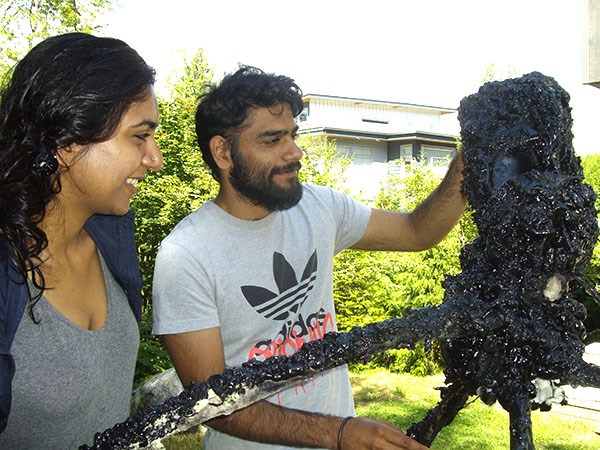��
For their Vancouver Biennale artists-in-residence project, Pallavi Paul and Sahej Rahal plan to present Squamish residents with a film depicting a vision of the community at some point in the future. But though it may contain an element of science fiction, it’s intended to be completely grounded in present realities.
“Poetry inspires us. Literature inspires us. Technology does, too. But we are not transcendentalists,” Paul, who hails from Delhi, India, said during a recent meeting at the Quest University residence where the two are staying during their month in Squamish.
“We’re not really into exploring another reality. The future is a way of understanding the world we live in here and now, and it very much excites us.”
Paul and Rahal, from Mumbai (Bombay), are up-and-coming artists individually in India. The two — who arrived for their first visit to Canada in late May — decided to collaborate on some projects beginning in 2013. They were nominated in their home country through an organization called Khoj (translated “search”) to be part of Vancouver Biennale, a two-year artistic tour de force that includes visits to Squamish by renowned and up-and-coming artists.
Like the pair from India, Miguel Horn and Chris Landau are a good illustration of the “Open Borders/Crossroads Vancouver” theme chosen for the 2014-‘15 Vancouver Biennale. Without question, the two Philadelphia artists hail from an environment that’s nothing at all like Squamish.
Still, the sculptor and the animator/projectionist are working to interweave their talents and creativity under an umbrella that couldn’t be more local: local First Nations canoe-making and the Salish Sea.
After they were chosen to come to Squamish, the two started researching the region and discovered the Salish Sea — the First Nations name for the Georgia Strait, Puget Sound and the Strait of Juan de Fuca — crosses the U.S.-Canada border but also unites the region.
“We thought about how industry can affect the entire basin —��this whole watershed,” Horn said. “We thought about how sea-level rise from climate change might affect this area.
“We also wanted to work with the traditions of Squamish — including the Squamish Nation, logging and the marine industry.”
Back in Philly, Horn works with a state-of-the-art CNC (computer numerical control) fabrication machine that uses computer technology to carve out forms in all types of materials —��including wood.
After arriving in Squamish, the two began poking around and found that Leon Lebeniste, the furniture makers based in the Squamish Business Park, had a CNC machine.
That’s not the only partnership Horn and Laudau have forged, though. Their Salish Sea project involves making a 16-foot, coastal First Nations-style canoe using the CNC machine, and projecting images onto it. So it made sense that they would work with the likes of Ron Newman, a.k.a. “Chum” —��a Squamish Nation canoe maker who is passing on the tradition to the Nation’s youth.
Newman helped Horn and Landau locate a suitable piece of cedar and the two groups… well, split the proceeds and are working together to teach each other.
“They’ll get exposure to how we use the CNC fabrication and they’ll get exposure to how they build canoes traditionally,” Horn said.
Paul and Rahal are working with local materials. So far they’ve found sticks, milk cartons, a spike from an old vessel and even a bone fragment that they aim to use for their “vision of Squamish’s future” project.
“A walk along the beach can yield some interesting pieces,” Paul said. “There are hints here about Squamish and a very interesting past.”
An event that will include a “rough-cut” screening of Paul’s and Sahej’s Squamish Film Project, and the unveiling of Horn’s and Laudau’s Salish Sea Lab creation, is planned on Friday, June 27, from 4:30 to 6 p.m. at the Squamish Adventure Centre. Admission is free.��
The next set of up-and-coming artists-in-residence is to arrive July 1. Around the second week of July, Vancouver Biennale open-air museum artist Vik Muniz from Brazil and his team are set to arrive and remain for three weeks of creative work.
For info, including a volunteer application form, visit www.vancouverbiennale.com.




